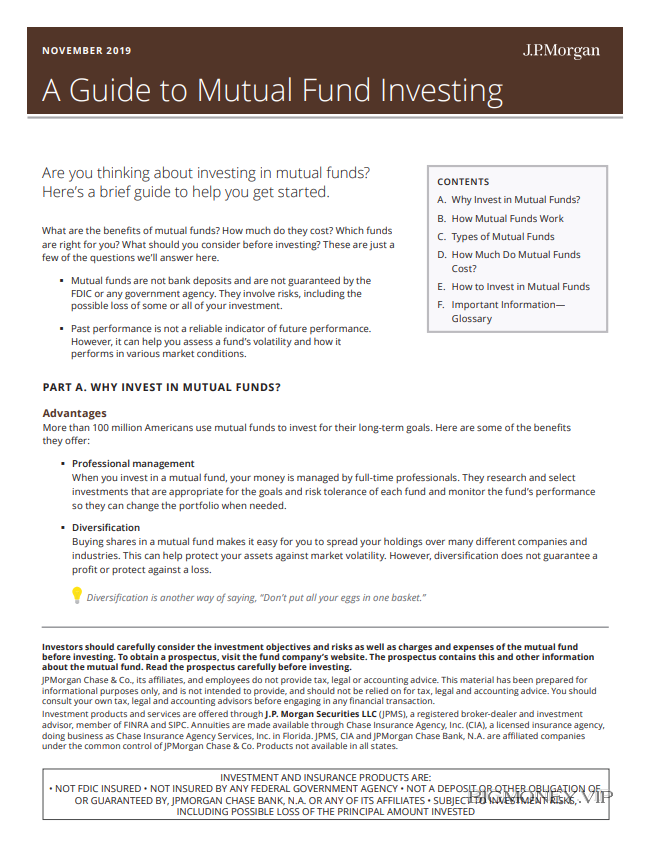A Guide to Mutual Fund Investing

§ Choice
Mutual funds give you a wide variety of choices to help meet your fnancial goals. You can invest for diferent
objectives, at diferent levels of risk and in diferent kinds of securities.
➠ See Part C to learn about diferent types of mutual funds.
§ Afordability
Mutual funds enable you to invest with a relatively small amount of money. Outside of a fund, it would generally
require a much larger investment to build such a diversifed portfolio.
§ Liquidity
You can generally sell your shares at any time and for any reason. However, there may be rare occasions when fund
sales are restricted due to extreme market conditions.
➠ See Part E for more information about buying and selling shares.
§ Automatic reinvestment
Mutual funds give you the option of reinvesting your dividends and capital gains in new shares of the fund, without
incurring a sales charge.
You can purchase fractions of a mutual fund share, so every dollar you reinvest goes right back to work in the fund.
Important considerations
While they have many benefts, mutual funds also have potential issues that investors should consider before deciding
to invest:
§ Risk
All mutual funds carry some degree of risk. Your investment will go up and down in value. You can lose some or all of
your money. Your earnings can fuctuate too.
➠ See Part C for more information about risks.
§ Cost
Regardless of how a fund performs, you must pay the sales charges, management fees and other expenses of the
fund. These costs will reduce your investment returns.
➠ See Part D for more information about costs.
§ Taxes
You may have to pay taxes on any income or capital gains earned by the fund. This is especially important at the end
of the year, when many funds distribute capital gains to investors.
➠ See Part E for more information about taxes.
§ Lack of transparency
You will not know the exact holdings of your fund in real time. (Fund holdings are reported with a delay.) Nor will you
have any infuence on which investments the fund’s managers buy or sell, or when they buy or sell them.
PART B. HOW MUTUAL FUNDS WORK
Mutual funds pool money from many investors and invest it in a portfolio of securities, such as stocks or bonds. Each share
of the fund equals a portion of ownership in its holdings and of the income it earns.
Here are fve things every investor should know about mutual funds:
§ Mutual funds are highly regulated
A mutual fund is actually an “investment company” whose purpose is to invest the assets of the fund. All mutual funds
are regulated by the U.S. Securities and Exchange Commission (SEC) to make sure they comply with a strict set of rules
designed to protect investors.
§ Each fund has a defned objective
Every mutual fund strives to achieve a specifc investment objective such as long-term growth or current income. This
objective is stated in the fund’s fact sheet and prospectus in order to help you choose funds that match your goals.
➠ See Part C to learn about diferent investment objectives.
§ Share value is determined daily
Mutual fund shares are priced at the end of each business day, based on the net asset value (NAV) of the fund’s
holdings. When you sell your shares, you will receive the current NAV minus any applicable sales charge or fees.
➠ See Part E for more information about NAV.
§ All income is passed through to investors
Mutual funds earn income through dividends and interest payments on the securities they hold. This income is
passed on to shareholders (after deductions for expenses) as fund dividends. Shareholders may take fund dividends
as cash or reinvest them in new shares of the fund.
Funds may pay dividends monthly, quarterly, semiannually or annually. Fund dividends are taxable as ordinary income.
§ Capital gains are passed through to investors too
Mutual funds earn capital gains (or losses) when they sell some of their securities. Net gains are passed on to
investors as capital distributions. Shareholders may take these distributions as cash or reinvest them in new shares
of the fund.
Capital distributions are paid annually, usually in December. Distributions are taxable as short-term or long-term
capital gains.
PART C. TYPES OF MUTUAL FUNDS
Diferent mutual funds ofer varying potential for return and risk. In general, funds with the potential for higher returns also
have higher volatility and greater risk of losing money. Understanding your fnancial goals and risk tolerance is the frst step
in choosing which funds could be right for you.
A mutual fund must usually hold at least 80% of its assets in the types of investment suggested by its name.
It may also hold up to 20% in other investments. Read the prospectus to see a fund’s specifc guidelines.
§ Stock (Equity) Funds
Many mutual funds invest in stocks, which are also called “equity investments” or “equities” because they are shares
of ownership in a company.
– Risks
Stock funds have higher market risk than bond funds or money market funds, because stock prices can fuctuate
dramatically. However, stocks have historically performed better than bonds or other investments over the long term.




